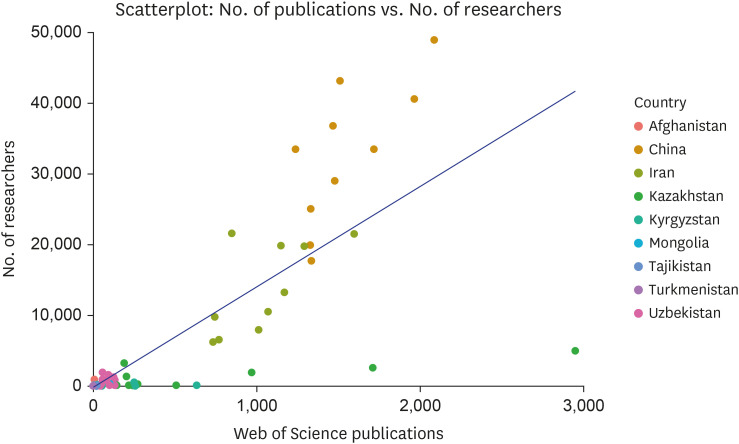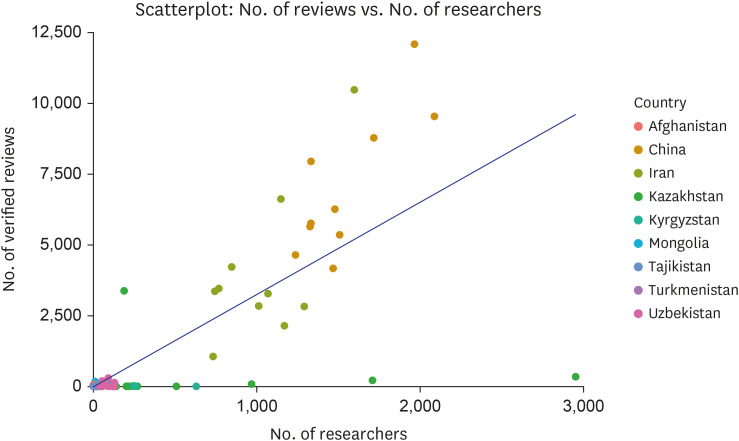J Korean Med Sci.
2021 May;36(21):e144. 10.3346/jkms.2021.36.e144.
Top Central Asian Educational Institutions on Publons: Analysis of Researchers and Reviewers
- Affiliations
-
- 1Department of Clinical Immunology & Rheumatology,Kalinga Institute of Medical Sciences (KIMS), KIIT University, Bhubaneswar, India
- 2Department of Gastroenterology,Sriram Chandra Bhanj Medical College and Hospital, Cuttack, India
- KMID: 2516368
- DOI: http://doi.org/10.3346/jkms.2021.36.e144
Abstract
- Background
The Publons platform provides integrated information on researchers, peer reviewers, publications and certain author metrics. Central Asia is a potentially growing region in terms of young researchers.
Methods
Using the inbuilt Publons search, the top institutes of nine countries of Central Asia and neighbours were identified and data on their reviewers, number of publications, number of peer reviews completed were extracted. These were compared with demographics of the countries such as population, gross domestic product, number of physicians and proportion of population enrolled for higher education.
Results
Amongst the top 15 institutes in Central Asia, China has claim to 12 while Kazakhstan has two and Iran has one. The number of top peer reviewers, number of verified reviews and Web of Science indexed publications from these top institutes varied directly with the number of researchers each had. Afghanistan, Tajikistan and Turkmenistan are not performing well on most of these while China seems to be an outlier on the upper edge of the graphs. There is good correlation between the number of researchers in the top institutes per country and both number of publications and number of completed reviews. The number of total publications per top ten institutes of each country has high correlation with various demographic parameters like total population (Spearman rho, ρ = 0.85), gross domestic product (ρ = 0.82), total number of physicians (ρ =0.72), and number enrolled for higher education (ρ = 0.93).
Conclusion
There appears to be much disparity among the rankings, number of researchers, reviewers and published manuscripts across various countries in Central Asia. The gross heterogeneity of Central Asia needs to be minimized by nurturing and mentoring potentially upcoming researchers in publication, peer reviewing as well as in ethics involved.
Keyword
Figure
Cited by 3 articles
-
Peer Reviewers in Central Asia: Publons Based Analysis
Sakir Ahmed, Marlen Yessirkepov
J Korean Med Sci. 2021;36(25):e169. doi: 10.3346/jkms.2021.36.e169.Comparative Analysis of Central Asian Publication Activity Using SCImago Journal & Country Rank Data in 1996–2021
Burhan Fatih Kocyigit, Ahmet Akyol, Makhmadshokh K. Gulov, Marlen Yessirkepov
J Korean Med Sci. 2023;38(14):e104. doi: 10.3346/jkms.2023.38.e104.Characteristics of Retracted Publications From Kazakhstan: An Analysis Using the Retraction Watch Database
Burhan Fatih Kocyigit, Alikhan Zhaksylyk, Ahmet Akyol, Marlen Yessirkepov
J Korean Med Sci. 2023;38(46):e390. doi: 10.3346/jkms.2023.38.e390.
Reference
-
1. Gasparyan AY, Gerasimov AN, Voronov AA, Kitas GD. Rewarding peer reviewers: maintaining the integrity of science communication. J Korean Med Sci. 2015; 30(4):360–364. PMID: 25829801.2. Gasparyan AY, Yessirkepov M, Voronov AA, Koroleva AM, Kitas GD. Comprehensive approach to open access publishing: platforms and tools. J Korean Med Sci. 2019; 34(27):e184. PMID: 31293109.
Article3. Publons researcher search. Accessed August 14, 2020. https://publons.com/researcher/?research_field=5029&order_by=num_reviews.4. Ahmed S, Pinto B. The peer review process in ASIA. Cent Asian J Med Hypotheses Ethics. 2020; 1(2):136–141.
Article5. Gaur PS, Gupta L. Social media for scholarly communication in Central Asia and its neighbouring countries. J Korean Med Sci. 2021; 36(4):e36. PMID: 33496088.
Article6. Adambekov S, Askarova S, Welburn SC, Goughnour SL, Konishi A, LaPorte R, et al. Publication productivity in Central Asia and countries of the former Soviet Union. Cent Asian J Glob Health. 2016; 5(1):261. PMID: 29138734.
Article7. Kavadichanda C. Journal metrics: different from author metrics. Indian J Rheumatol. 2020; 15(3):149–154.8. Bornmann L, Marx W, Gasparyan AY, Kitas GD. Diversity, value and limitations of the journal impact factor and alternative metrics. Rheumatol Int. 2012; 32(7):1861–1867. PMID: 22193219.
Article9. Ahmed S, Zimba O, Gasparyan AY. Moving towards online rheumatology education in the era of COVID-19. Clin Rheumatol. 2020; 39(11):3215–3222. PMID: 32939569.
Article10. Tollefson J. China declared world's largest producer of scientific articles. Nature. 2018; 553(7689):390.
Article11. Basu A, Foland P, Holdridge G, Shelton RD. China's rising leadership in science and technology: quantitative and qualitative indicators. Scientometrics. 2018; 117(1):249–269.
Article12. Yakhontova T. English writing of non-anglophone researchers. J Korean Med Sci. 2020; 35(26):e216. PMID: 32627440.
Article13. Yessirkepov M, Nurmashev B, Anartayeva M. A Scopus-based analysis of publication activity in Kazakhstan from 2010 to 2015: positive trends, concerns, and possible solutions. J Korean Med Sci. 2015; 30(12):1915–1919. PMID: 26713071.
Article14. Gasparyan AY, Nurmashev B, Udovik EE, Koroleva AM, Kitas GD. Predatory publishing is a threat to non-mainstream science. J Korean Med Sci. 2017; 32(5):713–717. PMID: 28378542.
Article15. Yamshchikov GV, Schmid GP. Publication practices and attitudes towards evidence-based medicine in central Asia. Lancet Glob Health. 2013; 1(2):e73–4. PMID: 25104158.
Article16. Ahmed S, Anirvan P. The true meaning of plagiarism. Indian J Rheumatol. 2020; 15(3):155–158.17. Misra DP, Ravindran V, Agarwal V. Integrity of authorship and peer review practices: challenges and opportunities for improvement. J Korean Med Sci. 2018; 33(46):e287. PMID: 30416407.
Article18. Gasparyan AY, Ayvazyan L, Akazhanov NA, Kitas GD. Conflicts of interest in biomedical publications: considerations for authors, peer reviewers, and editors. Croat Med J. 2013; 54(6):600–608. PMID: 24382859.
Article19. Meo SA, Al Masri AA, Usmani AM, Memon AN, Zaidi SZ. Impact of GDP, spending on R&D, number of universities and scientific journals on research publications among Asian countries. PLoS One. 2013; 8(6):e66449. PMID: 23840471.
Article20. Li M, Liu X, Zhang L. Scientific publications in public, environmental and occupational health journals by authors from China, Japan and Korea in East Asia: a 10-year literature survey from 2003 to 2012. Int J Occup Med Environ Health. 2015; 28(4):663–673. PMID: 26216306.
Article21. Meo SA, Usmani AM. Impact of R&D expenditures on research publications, patents and high-tech exports among European countries. Eur Rev Med Pharmacol Sci. 2014; 18(1):1–9.22. Yessirkepov M, Nurmashev B, Anartayeva M, Seksenbayev B. The author's response: educating researchers and editors: contributing to ethical publication activity. J Korean Med Sci. 2016; 31(3):476–477. PMID: 26955253.
Article23. Kelly T, Liaplina A, Tan SW, Winkler H. Reaping Digital Dividends: Leveraging the Internet for Development in Europe and Central Asia. Washington, D.C., USA: The World Bank;2017.24. Gould D, Kenett DY, Panterov G. Multidimensional Connectivity: Benefits, Risks, and Policy Implications for Europe and Central Asia. Rochester, NY, USA: Social Science Research Network;2018.25. Barroga E, Matanguihan GJ. Correcting language mistakes in qualitative research articles. Cent Asian J Med Hypotheses Ethics. 2020; 1(2):146–151.
Article26. Janz RF, Kutanov A. The case of NRENs in Central Asia. Cent Asian J Glob Health. 2012; 1(1):32. PMID: 29755864.
Article27. O'Doherty D, Dromey M, Lougheed J, Hannigan A, Last J, McGrath D. Barriers and solutions to online learning in medical education - an integrative review. BMC Med Educ. 2018; 18(1):130. PMID: 29880045.28. Gasparyan AY, Kitas GD. Best peer reviewers and the quality of peer review in biomedical journals. Croat Med J. 2012; 53(4):386–389. PMID: 22911533.
Article29. Zimba O, Gasparyan AY. Peer review guidance: a primer for researchers. Reumatologia. 2021; 59(1):3–8. PMID: 33707789.30. Misra DP, Agarwal V. Blaming the peer reviewer: don't shoot the messenger!! Indian J Rheumatol. 2020; 15(3):162–164.
- Full Text Links
- Actions
-
Cited
- CITED
-
- Close
- Share
- Similar articles
-
- Peer Reviewers in Central Asia: Publons Based Analysis
- Literature Analysis on Reporting Standards for Qualitative Research in Cancer-related Studies
- Educational goals and objectives of nursing education programs: Topic modeling
- Practical Tips of English Expressions for Non-Native English-Speaking Peer Reviewers
- Reflections as 2020 comes to an end: the editing and educational environment during the COVID-19 pandemic, the power of Scopus and Web of Science in scholarly publishing, journal statistics, and appreciation to reviewers and volunteers



